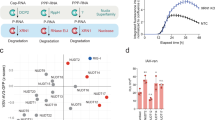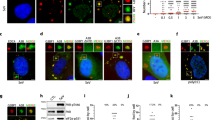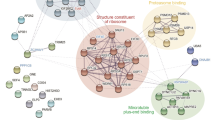Abstract
Since the identification of the antisense protein of HTLV-2 (APH-2) and the demonstration that APH-2 mRNA is expressed in vivo in most HTLV-2 carriers, much effort has been dedicated to the elucidation of similarities and/or differences between APH-2 and HBZ, the antisense protein of HTLV-1. Similar to HBZ, APH-2 negatively regulates HTLV-2 transcription. However, it does not promote cell proliferation. In contrast to HBZ, APH-2 half-life is very short. Here, we show that APH-2 is addressed to PML nuclear bodies in T-cells, as well as in different cell types. Covalent SUMOylation of APH-2 is readily detected, indicating that APH-2 might be addressed to the PML nuclear bodies in a SUMO-dependent manner. We further show that silencing of PML increases expression of APH-2, while expression of HBZ is unaffected. On the other hand, SUMO-1 overexpression leads to a specific loss of APH-2 expression that is restored upon proteasome inhibition. Furthermore, the carboxy-terminal LAGLL motif of APH-2 is responsible for both the targeting of the protein to PML nuclear bodies and its short half-life. Taken together, these observations indicate that natural APH-2 targeting to PML nuclear bodies induces proteasomal degradation of the viral protein in a SUMO-dependent manner. Hence, this study deciphers the molecular and cellular bases of APH-2 short half-life in comparison to HBZ and highlights key differences in the post-translational mechanisms that control the expression of both proteins.
This is a preview of subscription content, access via your institution
Access options
Subscribe to this journal
Receive 50 print issues and online access
$259.00 per year
only $5.18 per issue
Buy this article
- Purchase on Springer Link
- Instant access to full article PDF
Prices may be subject to local taxes which are calculated during checkout




Similar content being viewed by others
References
Bruhn RMR. Human lymphotropic viruses: HTLV-1 and HTLV-2. In: Richman DWR, editor. Clinical virology. 4th ed. Washington, DC: AM Press; 2017. p. 771–94.
Ciminale V, Rende F, Bertazzoni U, Romanelli MG. HTLV-1 and HTLV-2: highly similar viruses with distinct oncogenic properties. Front Microbiol. 2014;5:398.
Wang TG, Ye J, Lairmore MD, Green PL. In vitro cellular tropism of human T cell leukemia virus type 2. AIDS Res Hum Retrovir. 2000;16:1661–8.
Xie L, Green PL. Envelope is a major viral determinant of the distinct in vitro cellular transformation tropism of human T-cell leukemia virus type 1 (HTLV-1) and HTLV-2. J Virol. 2005;79:14536–45.
Currer R, Van Duyne R, Jaworski E, Guendel I, Sampey G, Das R, et al. HTLV tax: a fascinating multifunctional co-regulator of viral and cellular pathways. Front Microbiol. 2012;3:406.
Zhao T, Matsuoka M. HBZ and its roles in HTLV-1 oncogenesis. Front Microbiol. 2012;3:247.
Mesnard JM, Barbeau B, Cesaire R, Peloponese JM. Roles of HTLV-1 basic Zip factor (HBZ) in viral chronicity and leukemic transformation. potential new therapeutic approaches to prevent and treat HTLV-1-related diseases. Viruses. 2015;7:6490–505.
Journo C, Douceron E, Mahieux R. HTLV gene regulation: because size matters, transcription is not enough. Future Microbiol. 2009;4:425–40.
Kfoury Y, Nasr R, Journo C, Mahieux R, Pique C, Bazarbachi A. The multifaceted oncoprotein Tax: subcellular localization, posttranslational modifications, and NF-kappaB activation. Adv Cancer Res. 2012;113:85–120.
Watanabe T. Adult T-cell leukemia: molecular basis for clonal expansion and transformation of HTLV-1-infected T cells. Blood. 2017;129:1071–81.
Yamano Y, Sato T. Clinical pathophysiology of human T-lymphotropic virus-type 1-associated myelopathy/tropical spastic paraparesis. Front Microbiol. 2012;3:389.
Gaudray G, Gachon F, Basbous J, Biard-Piechaczyk M, Devaux C, Mesnard JM. The complementary strand of the human T-cell leukemia virus type 1 RNA genome encodes a bZIP transcription factor that down-regulates viral transcription. J Virol. 2002;76:12813–22.
Satou Y, Yasunaga J, Zhao T, Yoshida M, Miyazato P, Takai K, et al. HTLV-1 bZIP factor induces T-cell lymphoma and systemic inflammation in vivo. PLoS Pathog. 2011;7:e1001274.
Giam CZ, Semmes OJ. HTLV-1 infection and adult T-cell leukemia/lymphoma-A tale of two proteins: Tax and HBZ. Viruses. 2016;8:E161. https://doi.org/10.3390/v8060161.
Nicot C. HTLV-I Tax-mediated inactivation of cell cycle checkpoints and DNA repair pathways contribute to cellular transformation: ‘A Random Mutagenesis Model’. J Cancer Sci 2015; 2. https://doi.org/10.13188/2377-9292.1000009.
Shirinian M, Kambris Z, Hamadeh L, Grabbe C, Journo C, Mahieux R, et al. A transgenic Drosophila melanogaster model to study human T-lymphotropic virus oncoprotein Tax-1-driven transformation in vivo. J Virol. 2015;89:8092–5.
El Hajj H, El-Sabban M, Hasegawa H, Zaatari G, Ablain J, Saab ST, et al. Therapy-induced selective loss of leukemia-initiating activity in murine adult T cell leukemia. J Exp Med. 2010;207:2785–92.
Halin M, Douceron E, Clerc I, Journo C, Ko NL, Landry S, et al. Human T-cell leukemia virus type 2 produces a spliced antisense transcript encoding a protein that lacks a classic bZIP domain but still inhibits Tax2-mediated transcription. Blood. 2009;114:2427–38.
Douceron E, Kaidarova Z, Miyazato P, Matsuoka M, Murphy EL, Mahieux R. HTLV-2 APH-2 expression is correlated with proviral load but APH-2 does not promote lymphocytosis. J Infect Dis. 2012;205:82–6.
Yin H, Kannian P, Dissinger N, Haines R, Niewiesk S, Green PL. Human T-cell leukemia virus type 2 antisense viral protein 2 is dispensable for in vitro immortalization but functions to repress early virus replication in vivo. J Virol. 2012;86:8412–21.
Panfil AR, Dissinger NJ, Howard CM, Murphy BM, Landes K, Fernandez SA, et al. Functional comparison of HBZ and the related APH-2 protein provides insight into human T-cell leukemia virus type 1 pathogenesis. J Virol. 2016;90:3760–72.
Hivin P, Basbous J, Raymond F, Henaff D, Arpin-Andre C, Robert-Hebmann V, et al. The HBZ-SP1 isoform of human T-cell leukemia virus type I represses JunB activity by sequestration into nuclear bodies. Retrovirology. 2007;4:14.
Lowrey AJ, Cramblet W, Bentz GL. Viral manipulation of the cellular sumoylation machinery. Cell Commun Signal. 2017;15:27.
Everett RD, Boutell C, Hale BG. Interplay between viruses and host sumoylation pathways. Nat Rev Microbiol. 2013;11:400–11.
Nasr R, Chiari E, El-Sabban M, Mahieux R, Kfoury Y, Abdulhay M, et al. Tax ubiquitylation and sumoylation control critical cytoplasmic and nuclear steps of NF-kappaB activation. Blood. 2006;107:4021–9.
Pene S, Waast L, Bonnet A, Benit L, Pique C. A non-SUMOylated tax protein is still functional for NF-kappaB pathway activation. J Virol. 2014;88:10655–61.
Dassouki Z, Sahin U, El Hajj H, Jollivet F, Kfoury Y, Lallemand-Breitenbach V, et al. ATL response to arsenic/interferon therapy is triggered by SUMO/PML/RNF4-dependent Tax degradation. Blood. 2015;125:474–82.
Sahin U, Ferhi O, Carnec X, Zamborlini A, Peres L, Jollivet F, et al. Interferon controls SUMO availability via the Lin28 and let-7 axis to impede virus replication. Nat Commun. 2014;5:4187.
Journo C, Bonnet A, Favre-Bonvin A, Turpin J, Vinera J, Cote E, et al. Human T cell leukemia virus type 2 tax-mediated NF-kappaB activation involves a mechanism independent of Tax conjugation to ubiquitin and SUMO. J Virol. 2013;87:1123–36.
Komatsu T, Nagata K, Wodrich H. The role of nuclear antiviral factors against invading DNA viruses: the immediate fate of incoming viral genomes. Viruses. 2016;8:E290. https://doi.org/10.3390/v8100290.
Shiio Y, Rose DW, Aur R, Donohoe S, Aebersold R, Eisenman RN. Identification and characterization of SAP25, a novel component of the mSin3 corepressor complex. Mol Cell Biol. 2006;26:1386–97.
Kadamb R, Mittal S, Bansal N, Batra H, Saluja D. Sin3: insight into its transcription regulatory functions. Eur J Cell Biol. 2013;92:237–46.
Jean MJ, Power D, Kong W, Huang H, Santoso N, Zhu J. Identification of HIV-1 Tat-associated proteins contributing to HIV-1 transcription and latency. Viruses. 2017;9:E67. https://doi.org/10.3390/v9040067.
Khan MM, Nomura T, Kim H, Kaul SC, Wadhwa R, Shinagawa T, et al. Role of PML and PML-RARalpha in Mad-mediated transcriptional repression. Mol Cell. 2001;7:1233–43.
Cachat A, Chevalier SA, Alais S, Ko NL, Ratner L, Journo C, et al. Alpha interferon restricts human T-lymphotropic virus type 1 and 2 de novo infection through PKR activation. J Virol. 2013;87:13386–96.
Regad T, Saib A, Lallemand-Breitenbach V, Pandolfi PP, de The H, Chelbi-Alix MK. PML mediates the interferon-induced antiviral state against a complex retrovirus via its association with the viral transactivator. EMBO J. 2001;20:3495–505.
Ivanschitz L, Takahashi Y, Jollivet F, Ayrault O, Le Bras M, de The H. PML IV/ARF interaction enhances p53 SUMO-1 conjugation, activation, and senescence. Proc Natl Acad Sci USA. 2015;112:14278–83.
Thebault S, Basbous J, Hivin P, Devaux C, Mesnard JM. HBZ interacts with JunD and stimulates its transcriptional activity. FEBS Lett. 2004;562:165–70.
Acknowledgements
We thank the microscopy facility team of the Lyon SFR Biosciences. R.M., C.J., and F.L. are supported by ENS Lyon. L.D. is supported by ANR. J.T. was supported by the Fondation ARC pour la Recherche sur le Cancer. E.D. was supported by the Ministère de la Recherche. This work was supported by ARC and La Ligue Contre le Cancer “programme Équipe Labellisée” and INSERM.
Author information
Authors and Affiliations
Corresponding authors
Ethics declarations
Conflict of interest
The authors declare that they have no conflict of interest.
Electronic supplementary material
Rights and permissions
About this article
Cite this article
Dubuisson, L., Lormières, F., Fochi, S. et al. Stability of HTLV-2 antisense protein is controlled by PML nuclear bodies in a SUMO-dependent manner. Oncogene 37, 2806–2816 (2018). https://doi.org/10.1038/s41388-018-0163-x
Received:
Revised:
Accepted:
Published:
Issue Date:
DOI: https://doi.org/10.1038/s41388-018-0163-x
This article is cited by
-
Construction and validation of a two-gene signature based on SUMOylation regulatory genes in non-small cell lung cancer patients
BMC Cancer (2022)
-
Silencers of HTLV-1 and HTLV-2: the pX-encoded latency-maintenance factors
Retrovirology (2019)
-
Restriction factors in human retrovirus infections and the unprecedented case of CIITA as link of intrinsic and adaptive immunity against HTLV-1
Retrovirology (2019)



